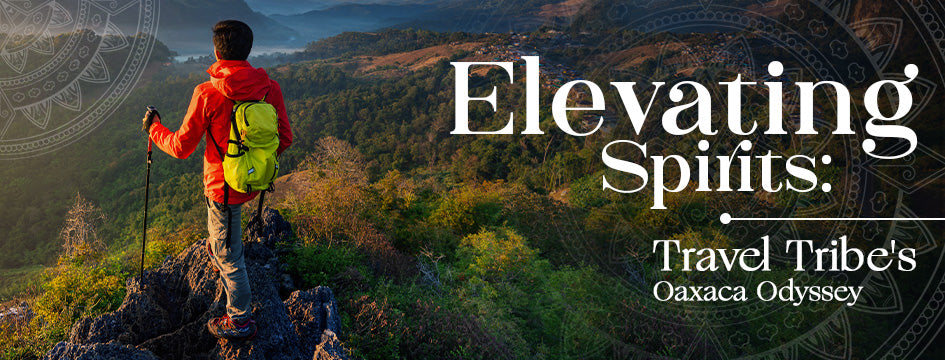
Accessing Higher Frequencies: Travel Tribe Oaxaca México
Oaxaca, Mexico, is a land steeped in rich traditions of family, spirituality, food, spirits, and indigenous culture. For years, it has been a top destination for chefs around the globe to hone their culinary dialect when it comes to traditional Mexican cuisine. It is known far and wide as the culinary capital of Mexico.
But more recently, it has become a tourist destination for those looking to explore the various ecosystems and all that the local culture has to offer specific to the region and without the crowds of the larger Mexican cities.
With respect to the food culture, you are sure to be blown away whether you visit one of the sprawling markets, top restaurants or just grab a taco from one of the many street vendors.
Food Recommendations: Concerning the food culture, you will be blown away, whether you visit one of the sprawling markets or top restaurants or just grab a taco from one of the many street vendors.
Oaxaca is probably best known as the birthplace of mole, and each chef or family has their interpretation. Mole is a sauce that is complex and flavorful and made from a unique combination of spices, chilies, and other ingredients.
It is generally served over various proteins with homemade corn tortillas. Be sure to also sample the local cheese called Quesillo, which is string cheese and used for tacos and quesadillas. Other popular foods are pastries, bread, grilled meats at the market, tamales, and, of course, the local salt blends made with chilis, salt, and either grasshoppers or crickets.
Market Recommendations: Mercado 20 De Noviembre - Check out Irving’s for Some Grilled Meats; Central de Abastos -Check out Dona Vale for Mole
Restaurant Recommendations: La Popular, Alfonsino, Pitona, Levandura De Olla, Orijen.
No trip to Oaxaca is complete without learning and sampling the local Mezcal culture. About 20 minutes outside the city, you will come to sprawling hills of Agave plants and mescal distilleries. There are also plenty of Mescal bars in town, and all restaurants have various local blends.
Mescal is the smokier cousin of tequila. Tequila is generally only made with blue agave and is cooked in an oven before being milled, fermented, and distilled. Mescal, on the other hand, comes from various agave plants all of which have been grown anywhere from 8-25 years.
They are then put in large pits in the local dirt, on top of heated lava coals, and then covered with more local dirt and allowed to roast in the earth for one week before moving on to milling, fermentation, and distilling.
The roasting of the agave in the earth is what gives mescal its smokey and unique flavor; the vegetation grown on the land within proximity adds to the complex flavor profile.
The Espadin agave is the most common and grown generally on the land of the production. But if you can try Mexcal made from the Tepezate or Tobala Agave, both of these are harvested in the wild and are allowed to grow upwards of 25 years for complex, smokey, and sweet flavors.
Now that your belly is full and your mouth is watered with the liquid of the gods, it’s time to explore the local religious sites and spiritual history.
The Spanish brought the church here in the mid-1500s at which time beautiful churches such as the Oaxaca Cathedral were built. Spend some time in these beautifully adorned cathedrals and feel the energy and warmth.
As an aside, it is believed that these mushrooms were introduced to the West via Maria Sabina in the 1950s. Many people still travel to the town of San Jose del Pacifico for about three hours from the main city where they are plentiful, legal, and ceremonies are held regularly.
Back to the Zapotecs, two sites that are worth visiting to dive deeper into the culture and rituals of the Zapotecs are Monte Alban and Milta.
Monte Alban sits on the hills overlooking the three valleys of Oaxaca. It was inhabited from 500 BC to 700 CE. With remarkable architecture, tombs, ball courts, and observatories, it is truly a remarkable site to behold. It boasts some of the most beautiful panoramic views of the area and allowed the Zapotecs a strategic advantage over any would-be attackers. It is an important archeological site and worth a half day’s visit so you can dive further into the culture.
Milta, “Place of the Dead.” is the more spiritual site. It was founded by the Zapotecs but later conquered by the Aztecs who influenced the culture. Palaces, temples, and tombs can be found here, all with similar carvings that relate to sacred geometry and the people's innate understanding of spirituality and the cosmos. They incorporated sacred geometry into the tombs and walls to connect with the divine and enhance the spiritual energy of the site.
The fret motif is evident throughout, which is one of the most well-known patterns and represents the connection between earthly and spiritual realms. The alignment of spirituality and cosmological beliefs is a testament to the Zapotecs' understanding of mathematics, aesthetics, and symbolism encompassing their spiritual belief systems.
There are other notable sites to visit, such as Hierve El Agua, the petrified waterfalls, and, of course, for the adventurous, a few days in the beach town of Puerto Escondido, which is a 20-minute flight or an 8-hour drive. Although a new direct road should be completed this summer cutting down the drive time to 3 hours.
We hope the above spiritual and food journey is one many of our Higher Frequencies Travel Tribe get to partake in. We loved it, and we know you will too. We suggest 4-5 days minimum if you are not going to the beach area or the San Jose del Pacifico, and if you are, you will need a good week for travel.




